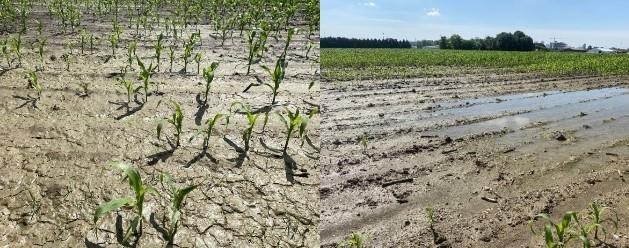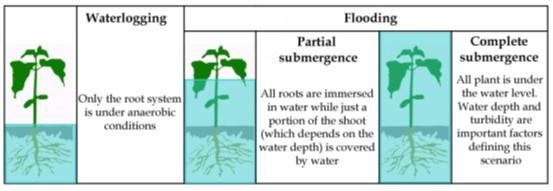Excess water challenges plant growth and fitness in farming systems. Depending on the geography, dramatic fluctuations and extremes in weather patterns have been experienced in Ohio, the US, and other parts of the world (e.g., droughts, floods). Research has shown that such events have increased in frequency and intensity over the past 50 years, making farming more challenging.

Not new to Ohio, wet conditions have been reportedly repeated in the last several weeks of the crop season, from April, May, and the first half of June of 2022. As a result, the crop has faced unfavorable conditions (Figure 1), and farmers have started to think about adjusting decisions for the rest of the season to reduce the impact of the damage.

Figure 1. Corn field under waterlogged and flooded conditions, Franklin County-Ohio, June 8, 2022.
The reports have ranged from waterlogging (i.e., the root system is under anaerobic conditions) to flooding (i.e., roots and some aboveground vegetation underwater) conditions (Figure 2). An excess of water has negative effects that can range from delaying planting, reduced seed/plant vigor, changes to normal growth/development, nutrient losses, water quality concerns, soil erosion, reduced nutrient uptake, and increased susceptibility to pests and disease pressures. Any of these conditions can have a detrimental impact on early crop establishment, continued growth, and development, and ultimately, it can reduce yields.

Figure 2. Plants encounter different scenarios due to excess water ranging from waterlogging to complete submergence. Source: Striker, 2012.
Nitrogen (N) is the primary nutrient of concern under waterlogged or flooded conditions. Nitrogen, particularly the nitrate form (NO3-), is a very mobile nutrient in the system (e.g., soils, plants, water, air), and can be lost due to leaching and denitrification. Therefore, nitrogen fertilizer applications in corn are often split into different timings (e.g., pre-planting, at planting, after planting) to gain N use efficiencies. Additionally, split applications can avoid losing the season’s N budget due to excess rain events.
Ohio base nitrogen rate recommendation comes from the Corn Nitrogen Rate Calculator (CRNC) found at http://cnrc.agron.iastate.edu/. The suggested nitrogen rate assumes best management practices for timing and placement of N. This tool does not provide recommendations for splits, percentages, sources, or forms to apply.
For applications yet to happen, here is a list of adjustments to consider:
Adjusting nitrogen fertilizer application timing: this is probably one of the most practical options. In general, corn requires approximately 30 lbs N before the V6 stage, and the remainder of the N uptake occurs after that growth stage. Consider lower pre-plant rates and plan to apply the rest of the needed N later in the season (possibly post-flood) to help minimize losses. Current research is underway to develop recommendations for combinations of pre-plant and side-dress rates. We will share our findings as they unfold.
Adjusting nitrogen fertilizer sources: some examples are enhanced efficiency fertilizers (EEFs) and organic fertilizers. Using EEFs may prevent and help minimize N losses such as leaching, denitrification, and volatilization. Although organic fertilizers are an option, the mineralization of organic sources (e.g., manure) may be affected by excess water. Additionally, some research suggests a connection between soil potassium (K) levels and N uptake, so ensuring soils are not limiting for K is important to optimize N uptake. We are looking into how N sources impact grain yield in the face of flooding, with results to come.
Adjusting nitrogen fertilizer placement/method: using more efficient placements, for example, 2 x 2. Delaying fertilizer applications becomes needed if field conditions do not allow equipment traffic across the field. The starter N can meet early crop needs until conditions improve. There still may be an ability for later-season N application (mid vegetative) with high clearance equipment if the traditional application windows for side-dressing (V4-V8) are too wet.
Additionally, besides adjusting nitrogen management, a list of other factors to consider include:
Crop insurance: the availability of crop insurance has been and continues to be a good risk management tool. The crop insurance payouts to farmers in the US for flooding damage averaged $24 billion between 2001 and 2011. With increases in the frequency and intensity of these events, economic losses are expected to be larger in current times.
Better hybrids: breeding programs have allocated some efforts to create materials with adaptive traits and acclimation responses to waterlogging and submergence of aboveground tissues. At the plant level, ethylene regulation seems to drive one of the adaptive responses. With current records, it is relevant to consider genetic materials when ordering seeds for the following crop season (i.e., flood-tolerant hybrids).
Use of cover crops: cover crops bring many services to the system. Those services relevant for flooding conditions include nutrient retentions, better soil structure, nutrient cycling, increased organic matter, reduced soil crusting issues, and increased biological activity. Note that biological activity is one of the fundamental processes for nutrient cycling (i.e., nitrogen) and making that into plant-available forms. However, cover crops may also cause challenges with soil dry-down, harboring negative pests, or causing additional logistical constraints (e.g., correctly timing termination). Research studies are underway in Ohio to answer some of these questions.
Use of drainage: drainage systems can be used when excess water is a concern. Drainage systems help to release the excess water present in a field. Different options exist; some are subsurface tile drainage and raised bed cultivation. These options are influenced by equipment availability, land topography, costs, and labor.
Adjust planting dates and replanting: planting later under better conditions can turn out better than planting early when conditions are not the best (e.g., wet soils) as an “avoidance” mechanism. Planting can be delayed if corn is used for silage. Depending on when flooding occurs, replanting can also be an option. However, later plantings would be compromised and may produce low yields due to the shortened growing season. If replanting, it is important to consider adjustments to shorter maturities to increase the chances of success. Recent work from Ohio suggested that good yields can be achieved with hybrids ranging in relative maturities of 95-104, access these results here. One of the main risks of replanting (i.e., late planting) is that the crop can get frost killed in the fall before achieving physiological maturity. Information on Delayed Corn Planting is available here.
Pest & disease monitoring & applications: seedling issues can be increased due to flooded and waterlogged soil conditions. Some factors that can exacerbate this concern include soil compaction, stunted plant growth, low seed quality, low seed/plant vigor, and crusted soils. In general, and depending on the timing and duration, any pest or disease presence can reduce plant growth and yields. To alleviate some of this, periodic monitoring and spray applications may become necessary.
Summary
A comprehensive understanding of corn’s morphological, developmental, and physiological responses to waterlogging and flooding is critical for preparing and adjusting to such conditions to minimize yield and economic losses. Some of this work is currently under research in Ohio conditions; updates and results will be shared as we learn more.
Source : osu.edu